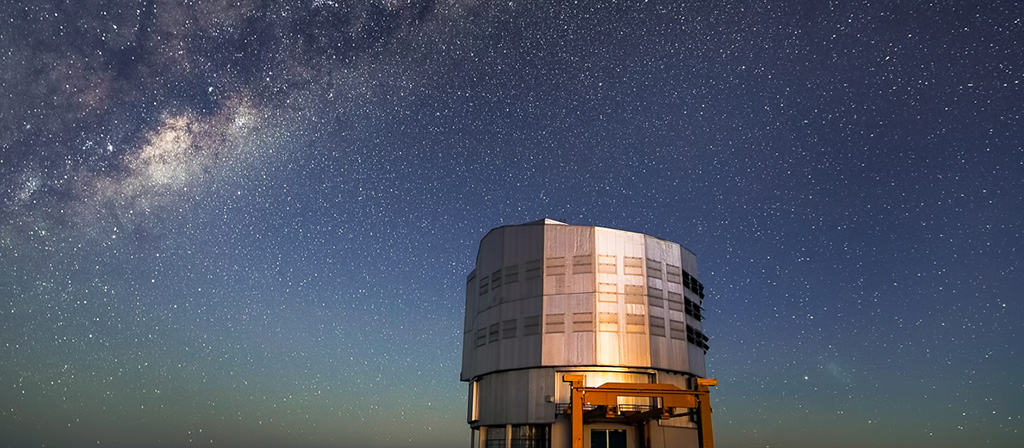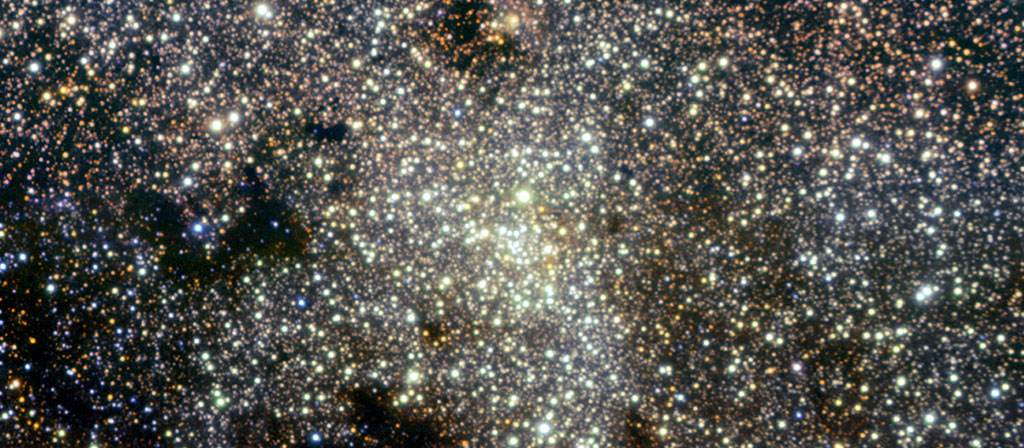[:en][three_fourth last=»no» spacing=»yes» center_content=»no» hide_on_mobile=»no» background_color=»» background_image=»» background_repeat=»no-repeat» background_position=»left top» hover_type=»none» link=»» border_position=»all» border_size=»0px» border_color=»» border_style=»» padding=»» margin_top=»» margin_bottom=»» animation_type=»» animation_direction=»» animation_speed=»0.1″ animation_offset=»» class=»» id=»»][fusion_text]
By Rodrigo Contreras Ramos, MAS postdoctoral researcher
The Universe is bursting of galaxies with many shapes and sizes. What kind is ours? Trying to infer the morphology of the Milky Way is not a simple thing to do. We live inside it, and we can’t just go on a trip outside of it and take a picture because the distances involved are very long and an interstellar voyage of this kind would take thousands of millions of years. Our only option is to rely in our ingenuity.
Two centuries ago, the German astronomer, William Herschel, put the first piece of the jigsaw. By counting stars in several directions, he concluded that we live in the inner part of a flattened and irregular stellar system. Even though the general idea is correct, he missed two points. He neither knew that the interstellar environment is full of dust that blocks the starlight, so that the furthest stars remain unseen, nor he knew a reliable method to estimate how far the stars were.
Measuring the distance of the stars is challenging but not impossible. The first thing that someone might think is that the stars that seem dim are farther away and the brighter ones are closer. This concept would be right if the stars were all the same and this is exactly what Herschel assumed in his calculation. But reality is far from that. Stars come in different colors and brightness, which means that is quite difficult to tell whether a luminous dot in the sky comes from a bright star far away or a dim star nearby. This is similar to the impossibility of distinguishing between a flashlight beam coming from a boat on the seashore and a huge lighthouse a few kilometers away. Luckily for astronomers, several methods to measure stellar distances have been discovered, and one of them is provided by pulsating stars, one of the types of stars that display periodical change in brightness. Nowadays, we know measuring the time that a pulsating star takes to light up and down is enough to estimate its distance.
There is also a trick to observe through the dust. Although the visible light that stars produce cannot pass through the thick “smog” curtains that tore us apart, stars also emit other types of electromagnetic radiation that are able to reach us. The infrared radiation is an example of this kind of “magic” light and, although our eyes cannot see it our cutting-edge telescopes do.
Thus, thanks to the ability to observe through the dust and to compute distances, we have developed the current idea of what our galaxy is. We live in a disk-shaped stellar system with a protuberance in the center, called Bulge. So, if you take 2 pan fried eggs and stick them together back to back (on the flat sides) the resulting object would have, basically, the shape of the Milky Way. We are living in the “white” zone, 27.000 light years away from the center of the “yolk”.
In the ’90s, it was suggested that the galactic “yolk” had instead the shape of a bar viewed side on, and this was actually confirmed by the Spitzer infrared space telescope in 2005. Recently, we discovered that this bar is indeed the result of two components, one with the shape of a peanut and the other with the shape of a sphere. Thus, new discoveries about the morphology of our galaxy follow one another thanks to even more detailed studies.
We wanted to take on the challenge of studying the Milky Way’s most difficult access region, its heart. Since 2010, the project Vista variables in the Via Lactea (https://en.wikipedia.org/wiki/Vista_Variables_in_the_Via_Lactea) has been using the VISTA telescope, located at Cerro Paranal, to observe the infrared radiation that millions of stars located near the galactic center -and in part of the galactic disk too- emit. Our work consisted in comparing all the images of the inner area with the aim of detecting stars showing variations in their brightness. Our interest has been mainly focused on identifying a very special type of pulsating star called RR Lyrae (RRL). RRL stand out because they are considered one of the oldest stars in our Universe and finding them means that we have real witnesses of the Galaxy nucleus formation process.
Therefore, in 2016 (https://www.eso.org/public/news/eso1636/) and after months of working, we were able to detect for the first time this kind of variable stars, 27.000 light years away from us, located thus in the very center of the Galaxy. Their mere presence tells us that this region could have formed at least 10.000 million years ago since this is the minimum age estimated for RRL stars. During 2018, we have extended the searching area and not only we have found more RRL but also the comparison between images has allowed us to study their movements across the space. Our main result (http://adsabs.harvard.edu/abs/2018ApJ…863…79C) was that the oldest fossils of our Galaxy, represented by the RRL population, move around the galactic Bulge as a swarm of bees and they did not show any evidence of being rotating, as an ensemble, around this center. This fact might be suggesting that the inner and oldest component of the Bulge was born due to the gravitational collapse of a gas cloud formed shortly after the Big Bang.
Amongst the thousands of millions of galaxies that we are able to observe the Milky Way is special not only because we are living inside it, but also due to the detailed studies we can carry out. This means that new discoveries about its shape and history are around the corner, and I am sure that our team will devotedly and excitedly keep working to find more clues that might help us to better understand when and how the heart of the Milky Way did start to beat.
Main image: The center of the Milky Way as seen in infrared light[/fusion_text][/three_fourth][one_fourth last=»yes» spacing=»yes» center_content=»no» hide_on_mobile=»no» background_color=»» background_image=»» background_repeat=»no-repeat» background_position=»left top» hover_type=»none» link=»» border_position=»all» border_size=»0px» border_color=»» border_style=»» padding=»» margin_top=»» margin_bottom=»» animation_type=»» animation_direction=»» animation_speed=»0.1″ animation_offset=»» class=»» id=»»][testimonials design=»classic» backgroundcolor=»» textcolor=»» random=»» class=»» id=»»][testimonial name=»By Rodrigo Contreras Ramos, MAS postdoctoral researcher» avatar=»none» image=»» image_border_radius=»» company=»» link=»» target=»_self»]»Trying to infer the morphology of the Milky Way is not a simple thing to do. We live inside it, and we can’t just go on a trip outside of it and take a picture because the distances involved are very long and an interstellar voyage of this kind would take thousands of millions of years. Our only option is to rely in our ingenuity.»[/testimonial][/testimonials][/one_fourth][fusion_text]
[/fusion_text][:es][three_fourth last=»no» spacing=»yes» center_content=»no» hide_on_mobile=»no» background_color=»» background_image=»» background_repeat=»no-repeat» background_position=»left top» hover_type=»none» link=»» border_position=»all» border_size=»0px» border_color=»» border_style=»» padding=»» margin_top=»» margin_bottom=»» animation_type=»» animation_direction=»» animation_speed=»0.1″ animation_offset=»» class=»» id=»»][fusion_text]
Por Rodrigo Contreras Ramos, investigador postdoctoral MAS
El Universo está lleno de galaxias de distintas formas y tamaños ¿De qué tipo es la nuestra? Descifrar la morfología de la Vía Láctea no es tarea nada de fácil. Vivimos inmersos en ella y no podemos viajar para tomar una selfie desde afuera, pues las distancias involucradas son demasiado grandes y tardaríamos miles de millones de años en una travesía interestelar de este tipo. No nos queda otra que usar el ingenio.
Dos siglos atrás, el astrónomo alemán William Herschel puso la primera pieza del puzzle. Simplemente contando estrellas en direcciones diferentes, Herschel concluyó que vivíamos al interior de un sistema estelar aplanado e irregular. Si bien la idea general es correcta, había dos puntos que no consideró. Él no sabía que en el medio interestelar existe una gran cantidad de polvo que bloquea la luz de las estrellas impidiendo ver las que se encuentran más lejanas. Por otro lado, tampoco conocía un método preciso para estimar que tan lejos se encontraban las estrellas.
El problema de medir la distancia a las estrellas es complicado de resolver, pero no imposible. Lo primero que uno tendería a pensar, es que las estrellas que se ven débiles están lejos, y las que aparecen brillantes están más cerca. Esto sería cierto si todas las estrellas fueran iguales y es justamente lo que Herschel asumió en su cálculo, pero la realidad es muy distinta. Existen estrellas de diferentes brillos y colores y esto quiere decir que no es posible distinguir si un punto luminoso en el cielo proviene de una estrella brillante lejana o de una estrella débil cercana, al igual que no es posible distinguir la luz de una linterna que proviene de un bote a la orilla de la playa o de un enorme faro a algunos kilómetros de distancia.
Afortunadamente para los astrónomos, se han encontrado variados métodos para deducir distancias estelares y uno de ellos lo proveen las estrellas pulsantes, uno de los tipos de estrellas que varían su brillo periódicamente. Hoy sabemos que basta simplemente medir el tiempo que demora una estrella variable pulsante en «prenderse y apagarse» para estimar su distancia.
También existe un truco para mirar a través del polvo. Si bien la luz visible que emiten las estrellas no es capaz de atravesar las espesas cortinas de «smog» que nos separan, otros tipos de radiación electromagnética provenientes de ellas si logran llegar hasta nosotros. La radiación infrarroja es un ejemplo de este tipo de luz «mágica» y aunque nuestros ojos son completamente ciegos a ella, no lo son nuestros modernos telescopios.
Así, gracias a la capacidad de observar a través del polvo y de calcular distancias hemos podido hacernos la idea actual de lo que es nuestra galaxia. Vivimos en un sistema estelar que tiene forma de disco con una protuberancia al centro llamado Bulbo. Toma 2 huevos fritos y únelos por la parte de abajo, espalda con espalda: el objeto resultante tendrá, básicamente, la forma de la Vía Láctea. Nosotros vivimos en la «clara», a unos 27.000 años luz del centro de la «yema».
En los años 90 se especuló que la «yema» galáctica tenía más bien la forma de una barra vista de perfil y esto se confirmó con el telescopio espacial infrarrojo Spitzer en el año 2005. Recientemente descubrimos que la barra es en realidad la suma de dos componentes, una con forma de maní y otra con forma de esfera. Así, nuevos descubrimientos sobre la morfología de nuestra galaxia se suceden gracias a estudios cada vez más detallados.
Nosotros quisimos tomar el desafío de estudiar la región de la Vía Láctea de más difícil acceso, su corazón. Desde el año 2010 que el proyecto Vista Variables in the Vía Láctea (https://en.wikipedia.org/wiki/Vista_Variables_in_the_Via_Lactea) ha estado utilizando el telescopio VISTA, ubicado en Cerro Paranal, para observar la radiación infrarroja emitida por millones de estrellas que se ubican en dirección del centro galáctico (y un poco del disco galáctico también). Nuestro trabajo ha consistido en comparar todas las imágenes obtenidas de la zona más interna con el fin de detectar las estrellas que muestran variación en su brillo. Nuestro interés ha estado especialmente dirigido en identificar un tipo muy especial de estrellas pulsantes llamadas RR Lyrae (RRL). La particularidad de las RRL reside en que son consideradas entre las estrellas más antiguas del Universo y encontrarlas implica contar con verdaderos testigos del proceso de formación del núcleo de la galaxia.
Así, en 2016 (https://www.eso.org/public/news/eso1636/) y luego de meses de trabajo, hemos podido detectar por primera vez este tipo de estrellas variables a 27.000 años luz de nosotros, o sea en el centro mismo de la Galaxia. Su mera presencia nos indica que esta región tiene que haber empezado a formarse al menos hace 10 mil millones de años, pues esa es la edad mínima estimada de las RRL. Durante el 2018, hemos aumentado el área de búsqueda y no solo hemos podido encontrar nuevas RRL, sino que la comparación de imágenes también nos ha permitido estudiar sus movimientos en el espacio. El resultado que hemos encontrado (http://adsabs.harvard.edu/abs/2018ApJ…863…79C) ha sido que los fósiles más antiguos de nuestra galaxia, representados por las RRL, se mueven como un enjambre de abejas alrededor del núcleo galáctico y no muestran evidencia de estar rotando, en forma conjunta, en torno a este centro. Esto nos podría estar diciendo que la componente más vieja e interna del Bulbo nació debido al colapso gravitacional de una nube de gas formada poco después del Big Bang.
De las miles de millones de galaxias que podemos observar, la nuestra es especial no solo porque vivimos en ella sino que también porque la podemos estudiar con increíble detalle. Esto significa que nuevos descubrimientos están por venir sobre su forma e historia y tengo la certeza que nuestro grupo seguirá trabajando con dedicación y entusiasmo para encontrar más pistas que nos ayuden a entender mejor cuándo y cómo comenzó a latir el corazón de la Vía Láctea.
Imagen principal: Visión del centro de la Vía Láctea en luz infrarroja[/fusion_text][/three_fourth][one_fourth last=»yes» spacing=»yes» center_content=»no» hide_on_mobile=»no» background_color=»» background_image=»» background_repeat=»no-repeat» background_position=»left top» hover_type=»none» link=»» border_position=»all» border_size=»0px» border_color=»» border_style=»» padding=»» margin_top=»» margin_bottom=»» animation_type=»» animation_direction=»» animation_speed=»0.1″ animation_offset=»» class=»» id=»»][testimonials design=»classic» backgroundcolor=»» textcolor=»» random=»» class=»» id=»»][testimonial name=»Por Rodrigo Contreras Ramos, investigador postdoctoral del MAS» avatar=»none» image=»» image_border_radius=»» company=»» link=»» target=»_self»]»Descifrar la morfología de la Vía Láctea no es tarea nada de fácil. Vivimos inmersos en ella y no podemos viajar para tomar una selfie desde afuera, pues las distancias involucradas son demasiado grandes y tardaríamos miles de millones de años en una travesía interestelar de este tipo. No nos queda otra que usar el ingenio»[/testimonial][/testimonials][/one_fourth][fusion_text]
[/fusion_text][:]












